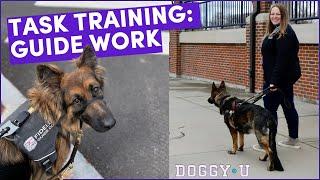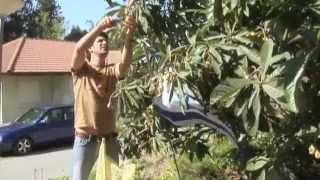
How to Train Obstacle Avoidance for Guide Dogs & Service Dog Leading and Navigation Tasks
Комментарии:

I'm legally blind and actually trained my own guide dog (with the help of a certified instructor in my country). I started teaching him the concept of straight lines and stopping at downward changes in elevation from day 1, simply because those were skills I needed him to know to even be able to take him for a walk. When he started getting reliable with the straight line/sticking to one side of the walkway, I went on to leash awareness, basically that if he went around a post he'd have to take the same path back to not tangle us up. Our obstacle avoidance started with all the electric scooters left here, there and everywhere, where I'd usually feel them with my cane and then walk around them, which, thanks to the prior leash awareness training, eventually lead to my dog pre-empting me in going around them. From there we just went along to new scenarios as needed/as they occured. In the beginning I just trained guide work using a leash clipped to a straight front harness, but after one time when I almost hurt myself tripping down a curb tha tmy dog had actually marked correctly (I just didn't react hin time) I finally got him a proper guide harness with a handle.He was about 2 years old at the time (the pandemic really slowed down our training) and has now been working in his guide harness for about two and a half years! I will be saving this video, though, for referance when it's time to start training his successor!
Ответить
Sure would love to see these videos. You are a big help for me
Ответить
what is your opinion on training a dog on all of the things? or do you recommend getting a dog for specializations? I have my puppo who I take everywhere with me and she's a psychiatric service dog in training, but I'm also interested in teaching her some grounding exercises as well as some guarding exercises. to build her confidence and my own. thanks for reading!
Ответить
Yes,please move videos on guide dog training. Also,mobility/wheelchair service training.
Ответить
The top service dogs in the mid-1900s were produced by Guide Dogs for The Blind Inc. with a 95% success rate here in the United States. The 5% that failed performed better than the 5% currently passed. The dogs lived longer healthier lives and achieved levels of responsibility and reliability they cannot achieve today. That is a 1000% decline in performance even with the lower standards and a 1000% increase in failure. These improvements in breeding and training techniques have come at great cost to both the dogs and the disabled that depend on them. For anyone wanting to know my sources, it's The New Knowlege Of Dog Behavior by Clarence Pfaffenberger and a quick online search will show you that about 5% is the average success rate for dogs that enter today's programs.
Ответить
I am visually impaired and have been training my dog to assist me. Thank you for the video. Very helpful.
Ответить
My pup is quite harness shy, which we are working hard on. Could I start this before she’s able to have a harness on, or is it best that they associate it with the harness?
Ответить
This is wonderful. I do not have a service dog, but I still want to train my dog this to stop at every end of the sidewalk because he like bolts across the road so that was really good. Thank you very much and I did hit the like button if that’s what you mean
Ответить
Definitely interested in a further video on training more leading tasks! If you find time. I'm SO excited to see you work with your new puppy! Mine just turned a year old and he's really showing a lot of promise; the early work and a lot of training tips from your videos have helped a ton.
A graceful exit task combined with a find the door task are big hurdles for me right now; my pup already knows the word "door" and that it means to sit at the door, and wait for a release word before passing through it (whether it's open or not, and if I open it, or someone else does). I hope that that's the first step for back-chaining the task, and that the next will be teaching him a cue to go and find a door to sit at, and then to do it with me in tow. Then a final (but actually the initial) cue that tells him to sit front and nose-boop my thigh repeatedly, as though he needed to go potty (it isn't actually his potty signal and he won't know that humans will assume that's what it means), so I can apologize to the humans and give him the cue to go find the door. Am I skipping steps, do you think? I may be oversimplifying, and I really have no idea how to teach him how to specifically seek an exit door, not just a closet or something.
My boy already does great at stepping to the correct side of narrow obstacles, like T-posts and tent poles, to stay with me on leash without tangling. He knows to stop at curbs and to wait for me to pick where we're going to go if there is a large obstacle in the way. It's just a huge step to go from that to training how to navigate in a crowd and indoors... which is generally where I need help, because my vision is usually fine outside in a low-crowd and low-stress situation. Only among humans do I struggle, and he adores humans, so right now he's actually more of a hindrance than a help (we still have a lot of training ahead of us before he will pass a public access test for ignoring people who want to greet him). I will be working on the basics of polite leash walking and manners, and ignoring friendly humans, but any suggestions for how to train leading tasks around people would be a great help in figuring out steps he can learn now that will help him learn that when he's ready.
Thank you as always for the amazing work you put into these!

It's even more fun when you drive a wheelchair!
Ответить
Girl, I just made a video myself and mentioned that I was thinking about if I needed a service dog for visual issues, and other issues too. Then I see this video a few hours later. Your also in the same state as me apparently
Ответить
Even though I do not have visual issues this is applicable to my city in Mexico I have balance and space issues and it is a bloody obstacle course popped up stones on side walks, cobblestones roads, some curbs are normal height others double. Even obstacles sticking out from walls on narrow sidewalks. So many women fall here it is called the city of fallen women.
Ответить
I liked hearing about what goes into training a guide dog as I have a guide dog from OCCUPAWS this is so cool
Ответить
More on guide work please and do a Playlist
Ответить
Terrific clip.
Thank you.
Back up, untangle, me first, you first are all handy cues Eps understands.
Go in a straight line is something we will enjoy working on handler learning to cue clear. Your tips were, as always, clear and helpful.
You are appreciated.
😎🐾

I'd love to know how to teach a dog to avoid moving cars. My dog seems to have no idea that cars will run right into her 😮
Ответить
I would love to see more guide work videos 😍 aspiring GDMI here 😂
Ответить
Thank you so much for this, it was so interesting and I can’t wait to teach this to my SD (who will be learning leading tasks). I’d definitely be interested in similar videos!
Ответить
Yes would love info on training gude dogs!
Ответить
I would love to see more videos about guide work! Thank you!
Ответить
Loved this video Laura! It was so interesting to watch and I love that we’re getting further away from
Punishment when training dogs 🙏💕

Definitly up for guide training !
Ответить
Please make more of the guide videos! It would help so much!!!
Ответить
Yes, absolutely interested! Thank you for sharing your knowledge. I'm training my ACD and my instincts, when I'm watching this video, is that you're avoiding the obstacle and the guide dog is just heeling. Could you explain how you go from that to having the dog signal you rather than follow you? Again, thank you for your dedication and for sharing your knowledge.
Ответить
I'd love more guide work. Specifically finding an exit.
Ответить
This is a great video and super interesting. I always wondered about the foundations of formal guide work and how the transition from on leash patterning to in harni guiding the end. Thanks so much as always for your detailed and will broken down explanations and I would very much interested in any more videos about Guide work you could show
Ответить
Yes please do an in-depth series on guide work training. Guide work training is the hardest to find. It is also the most dangerous to train for. Maybe historically this training has been guarded so that visually impaired people will be forced to go to an organization. There are many situation why an organization won’t accept someone so that person is left to pay a hard to find guide work trainer. These videos would be greatly appreciated. I’d like to learn the ins and outs of this so I have an idea of why my next dog may be making errors and how to work with them to correct the behavior.
Ответить
Yes please do an in-depth series on guide work training. Guide work training is the hardest to find. It is also the most dangerous to train for. Maybe historically this training has been guarded so that visually impaired people will be forced to go to an organization. There are many situation why an organization won’t accept someone so that person is left to pay a hard to find guide work trainer. These videos would be greatly appreciated. I’d like to learn the ins and outs of this so I have an idea of why my next dog may be making errors and how to work with them to correct the behavior.
Ответить
Thank you so much x
Ответить
I would LOVE a series on how guide dogs are trained. I find this stuff so interesting!
Ответить
It would be very cool to see how you teach your guide dogs
Ответить
Yes, more guide work videos, please, and thank you!
Ответить
Do some dog "naturally" avoid obstacles?
Ответить
For the first time this detail popped into my head, but it should've long back.
I'm sure this must come up and be handled in training, but I have to ask anyways:
How common/difficult is it to be able to get a trained SD or find a trainer to work with for left-handed people?
While we go through life learning to do so many things like righties, watching this obstacle and mobility focused video it just occurred to me just how very much holding a harness handle with my left hand would be problematic for the episodes that I'd need to. Those are Not Times when becoming right-handed for an uncertain length would be wise.
I know I'm not the first lefty in the world so it must be addressed with folks, but how common/difficult is the issue? Are dogs trained two work with either-handed folks or only one and you have to get a.... correct-sided... SD? Or, since they already know the tasks/behaviors can they easily learn to adjust to doing things on the right of a person?
Not meaning to do a hundred questions, sorry, it's just that as I said the issue and how big being a lefty affects things didn't register with me until now.
So, to put it more neatly: What is done about SDs, in general and mobility-aiding especially, and folks who are left-handed? With a trained dog or finding a trainer to work with?

Thank you!! I have really bad anxiety and mobility issues and I'm trying to train my sd guide for dissociation and sometimes blurry moments!
Ответить
Wow, such a good DD. Your dad is blessed. Great video.🙏
Ответить
Yes interested
Ответить
One of the biggest obstacles with somebody on the autistic spectrum is, we do not have depth perception. When our brains get very overstimulated, we bump into our environment. This skill is very crucial to safety. I am very awkward in my movement when I am in big crowds or in tiny spaces. My sensory issues also make me have challenges when I am in aisles or when I am walking. I noticed when I have Freja with me,she helps me walk more in straight line. I use a gentle to help with the pulling and training Freja to walk in a straight line on my left. I walk with Freja. I train this while Freja ,and I are walking along busy roads when I am in town ,and I try to teach her the straight line. I really like this video Laura because I feel that autism service dogs do need guiding and leading work as well as guide dogs. We do not judge distances well.
Ответить
❤❤❤
Ответить
That happens to be a niche topic I'm fascinated with, so I'd love a future series about training guide work!
Ответить
As always, another great video. I'm way behind because for the last week plus, I was taking care of twenty plus dogs, not including my own.
I'm glad you put out this content Laura, but Fidelco lost a great trainer when you left. When will you take my suggestion of having yourself cloned so you can be in more than one place? I think I'm slightly hurt and pouty that my suggestions are being ignored! Heeheehehee.

Before going blind I used to train dogs, after going blind I got a program guide dog and had an incredibly traumatic experience and have since met many more people with similar stories so I am now training my own guide dog. Thankfully from both my guide dog and training experience I don’t feel that I need any help however it’s great to see videos like this as it makes owner training way more accessible!
I also love that we’re moving away from aversive training techniques! The program in my country claims to be R+ yet we’re using outdated training techniques and overly harsh corrections.
I had my trainer at one point get in my dogs face, pick him up by the chest strap of the harness and scream at him. I was also told to slam my handle down hard on the dog’s hips, I have no issue with handle flicks when done properly and the dog is trained to respond but if I am slamming my knuckles into the dog’s hips and hurting my hand that’s abuse.
That’s not even getting into the fact that the dog was overweight, had incredibly long nails, gingivitis and a double ear infection. His coat was also heavily impacted and I later was told I am never allowed to bathe him as “it destroys the healthy oils in the coat.0
He was also incredibly sweet but had severe behavioural issues including but not limited to severe seperation anxiety and fear based reactivity.
I’ll leave it at that as this comment is already incredibly long but please do your research on what charities you support as things aren’t always as they seem!

I would love more videos on guide work. I am currently introducing my SDiT to guide work and would love love to hear your methods and tips. Great video as always! I love your way of explaining things and always understand it so well, which is not the norm hahaha
Ответить
Been a grad of The Seeing Eye for 20 years (currently on my 3rd Seeing Eye dog, 1st was a lab and currently with 2nd shepherd). I love learning about the thought process behind the training process for these amazing dogs and seeing the differences the different orga and private trainers use.
Ответить
Good information 😊 Thank you.
How does the dog know how to judge distance to keep you from touching obstacles?
And keeping safe crossing streets with traffic, I would love to know.🐾🙂

What organization certified you?
Ответить
I am very interested in guide work
Ответить
I’m blind in one eye and struggle in crowds so I would love more guide work vit
Ответить
I am definitely interested as I am planning on trying to train a Guide dog for myself
Ответить




![Ep. 17: Cozy Winter Camping in the Rain with Inflatable Tent and Wood Stove [ASMR, Heating Pad] Ep. 17: Cozy Winter Camping in the Rain with Inflatable Tent and Wood Stove [ASMR, Heating Pad]](https://ruvideo.cc/img/upload/c1NuMGN2RkpJU3o.jpg)





